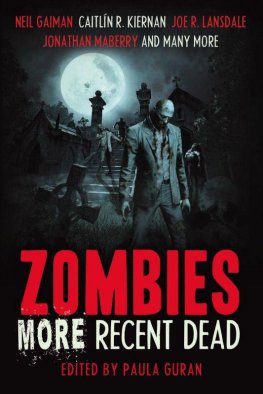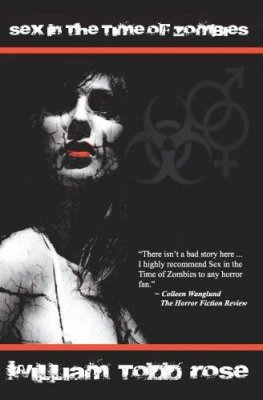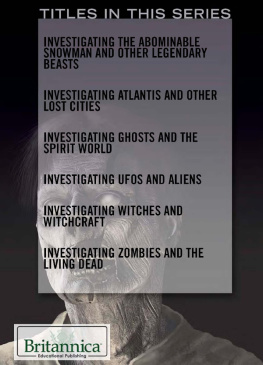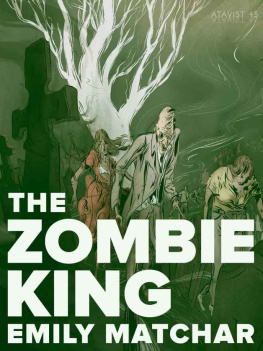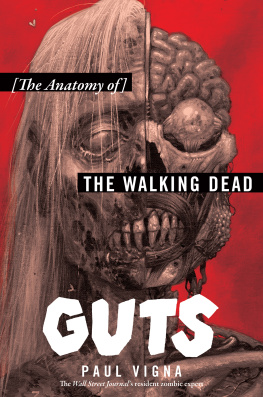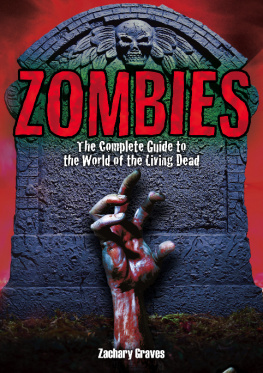Zombies
A Field Guide to the Walking Dead
Zombies
A Field Guide to the Walking Dead
By Dr. Bob Curran
Illustrated by Ian Daniels

Copyright 2009 by Bob Curran
All rights reserved under the Pan-American and International Copyright Conventions. This book may not be reproduced, in whole or in part, in any form or by any means electronic or mechanical, including photocopying, recording, or by any information storage and retrieval system now known or hereafter invented, without written permission from the publisher, The Career Press.
Zombies
Edited and Typeset by Gina Talucci
Designed by Lu Rossman/Digi Dog Design NYC
Cover and interior art by Ian Daniels
Printed in the U.S.A.
To order this title, please call toll-free 1-800-CAREER-1 (NJ and Canada: 201-848-0310) to order using VISA or MasterCard, or for further information on books from Career Press.

The Career Press, Inc., 220 West Parkway, Unit 12
Pompton Plains, NJ 07444
www.careerpress.com
www.newpagebooks.com
Library of Congress Cataloging-in-Publication Data
Curran, Bob.
Zombies : a field guide to the walking dead / by Bob Curran.
p. cm.
Includes bibliographical reference and index.
ISBN 978-1-60163-022-3
1. Zombies. I. Title.
GR581.C87 2009
398.21dc22
2008020791
Introduction
Out of the Tomb
T he jaw is slack with a small trace of dribbling saliva about the lips, the eyes are glazed, and on the bone the skin is desiccated, rotting, and withered; the footsteps are shambling and hesitant. The creature lurches from side to side as it moves, perhaps not truly under its own volition, but certainly with some sort of dreadful purpose. Its movements are sharp and jerky, similar to those of an automaton directed by some power outside itself. It moves relentlessly forward, craving living human flesh.
This is perhaps the representation of the walking deadthe zombiewith which we are all most familiar. It has appeared on both film and television screens so oftenin films such as George A. Romeros Night of the Living Dead or the cartoon antics of Scooby Doo on Zombie Island, for examplethat it has become almost ingrained into our psyche. But is this image an accurate one? Does it truly reflect what we believe the walking dead to be, or is it merely a reflection of a kind of cinematic beliefsomething that looks eerie and menacing on the big screen? And is the cultural perception of the risen dead a wider one than the slack-jawed zombie of celluloid fame?

The Zombie
Since earliest times, the return of the dead from beyond the grave has always been somewhat problematic. Some would no doubt welcome the return of their loved ones who have passed away; others might fear it. Some might welcome the dead back from the tomb; others might recoil from the returning cadavers. In some instances, the returning dead might signal good luck for a household; in others it might threaten immense and immediate danger. Other households take the return of a loved one from beyond the grave almost as a matter of course.
Strange Tales From Different Times
In 1993, my wife and I interviewed an old man, living in Wheathill (southwestern County Fermanagh in the north of Ireland). He was a well-respected figure in his community and a leader in the local church, but despite these things he told a strange story. As a boy, almost 80 years prior, he remembered his grandfather, who had been dead for less than a year, coming back to the house to sit at the fire and enjoy a pipe of tobacco, just as he had done in life. This had occurred at Halloween, when the dead were traditionally expected to return.
He just lifted the latch of the door and came in, the old man informed me, but we had his pipe ready for him. He also had a glass of whiskey in order to warm him after nearly a year in the clay, and sometimes even a meal (apparently he ate just as heartily as any living person). The old man remembered climbing on grandfathers knee, but feeling the touch of his skin to be very cold.
Were you not frightened? I asked him. He shook his head.
Why would I be? he replied. It was my own grandfather. The only difference that he noticed was that the returning cadaver could not speak. He could, however, communicate by gesture and by facial expression, but very few members of the family seemed to speak to him. He simply sat and enjoyed the goings on around himthe bustle of his relatives and descendantsjust as he would have done if alive.
As the evening drew to a close, the family retired to bed, leaving him sitting in front of the fire, smoking his pipe contentedly. When they came down the following morning, he had gone back to the tomb. No real fuss was made; it was just as if a favored relative had been visiting them.
Later, I spoke to the old mans sister who, without any collaboration or prompting, described the event just as he had told it. The cadaver had returned only once as far as she could remember, but she too remembered seeing it. (She lived close by, but had not been present when the story was related. Moreover, we went straight from the old mans house to hers.) After that, perhaps her grandfathers body had been too decomposed for him to return.
A committed Christian, the old man firmly believed that on certain nights of the year, such as Halloween, God briefly permitted the dead to return to bring comfort to their loved ones and provide a reassurance of the Afterlife. Such corpses could only return, he was sure, with Gods permission.
My wife suggested that he and his sister might be playing some sort of joke on us, but, as I said, why should they? Both were respected elderly members of the community, both were well connected in the local church, both were extremely serious when they told the story, and what did they stand to gain by telling it? I, myself, felt inclined to believe them, but I come from traditions that believe the dead might return.
Growing up in an extremely rural and isolated region of the Mourne Mountains in County Down, I was well aware of the strong perception that death was simply not the end, and that those who lay in local churchyards might, from time to time, return to the houses in which theyd once lived to be among their families once more. Whether or not such a return was wholly welcomed is another matter, but it was treated as a fact. On Halloween night several families set an extra place at the supper table in case a dead relative would turn up unexpectedly. One old lady, who lived not very far from us, spread gleeshins (fine dust and residue) from the fire out on her hearthstone before she went to bed on Halloween night. If they were disturbed in the morning, she knew that her dead ancestors had been there the previous evening, and had danced in front of the fireplace as they had done in times past. She would also leave a piece of cake and a glass of whiskey by the fire in case the dead would be hungry when they gathered therein very much the same way as we children left something for Santa Claus. I have no idea as to whether these items were consumed or not, but there were yet other instances of the returning dead.
Next page

